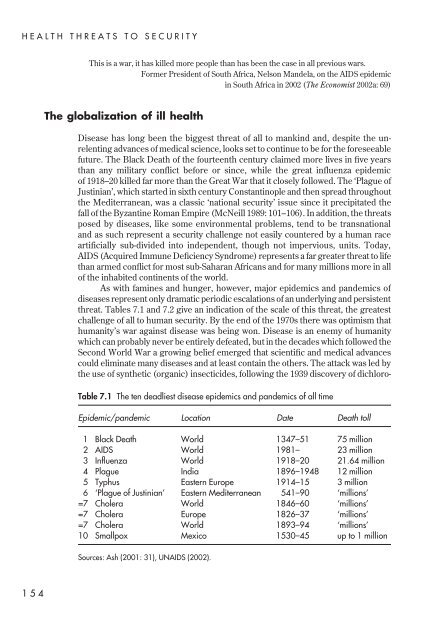Understanding global security - Peter Hough
Understanding global security - Peter Hough
Understanding global security - Peter Hough
You also want an ePaper? Increase the reach of your titles
YUMPU automatically turns print PDFs into web optimized ePapers that Google loves.
HEALTH THREATS TO SECURITY<br />
This is a war, it has killed more people than has been the case in all previous wars.<br />
Former President of South Africa, Nelson Mandela, on the AIDS epidemic<br />
in South Africa in 2002 (The Economist 2002a: 69)<br />
The <strong>global</strong>ization of ill health<br />
Disease has long been the biggest threat of all to mankind and, despite the unrelenting<br />
advances of medical science, looks set to continue to be for the foreseeable<br />
future. The Black Death of the fourteenth century claimed more lives in five years<br />
than any military conflict before or since, while the great influenza epidemic<br />
of 1918–20 killed far more than the Great War that it closely followed. The ‘Plague of<br />
Justinian’, which started in sixth century Constantinople and then spread throughout<br />
the Mediterranean, was a classic ‘national <strong>security</strong>’ issue since it precipitated the<br />
fall of the Byzantine Roman Empire (McNeill 1989: 101–106). In addition, the threats<br />
posed by diseases, like some environmental problems, tend to be transnational<br />
and as such represent a <strong>security</strong> challenge not easily countered by a human race<br />
artificially sub-divided into independent, though not impervious, units. Today,<br />
AIDS (Acquired Immune Deficiency Syndrome) represents a far greater threat to life<br />
than armed conflict for most sub-Saharan Africans and for many millions more in all<br />
of the inhabited continents of the world.<br />
As with famines and hunger, however, major epidemics and pandemics of<br />
diseases represent only dramatic periodic escalations of an underlying and persistent<br />
threat. Tables 7.1 and 7.2 give an indication of the scale of this threat, the greatest<br />
challenge of all to human <strong>security</strong>. By the end of the 1970s there was optimism that<br />
humanity’s war against disease was being won. Disease is an enemy of humanity<br />
which can probably never be entirely defeated, but in the decades which followed the<br />
Second World War a growing belief emerged that scientific and medical advances<br />
could eliminate many diseases and at least contain the others. The attack was led by<br />
the use of synthetic (organic) insecticides, following the 1939 discovery of dichloro-<br />
Table 7.1 The ten deadliest disease epidemics and pandemics of all time<br />
Epidemic/pandemic Location Date Death toll<br />
1 Black Death World 1347–51 75 million<br />
2 AIDS World 1981– 23 million<br />
3 InfluenzaWorld 1918–20 21.64 million<br />
4 Plague India 1896–1948 12 million<br />
5 Typhus Eastern Europe 1914–15 3 million<br />
6 ‘Plague of Justinian’ Eastern Mediterranean 541–90 ‘millions’<br />
=7 CholeraWorld 1846–60 ‘millions’<br />
=7 CholeraEurope 1826–37 ‘millions’<br />
=7 CholeraWorld 1893–94 ‘millions’<br />
10 Smallpox Mexico 1530–45 up to 1 million<br />
Sources: Ash (2001: 31), UNAIDS (2002).<br />
154
















